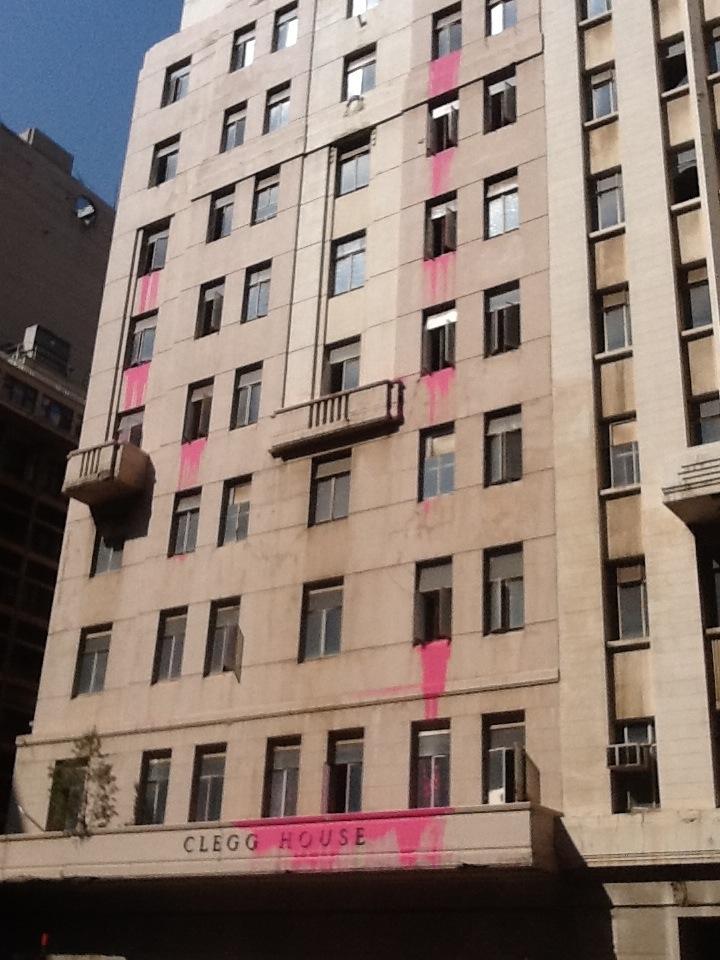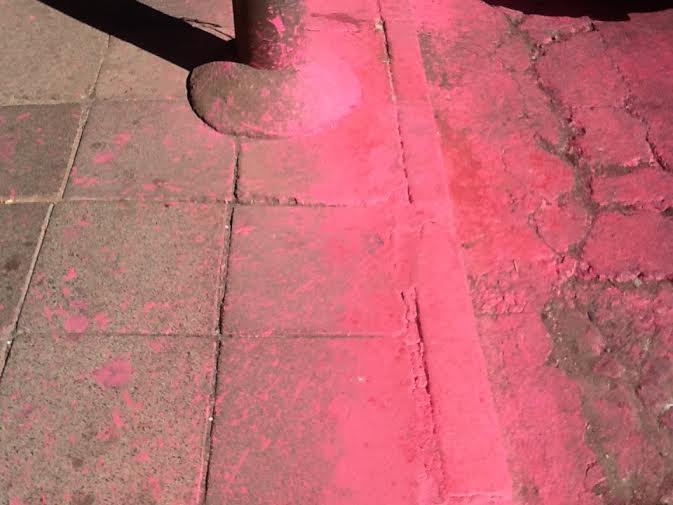Disclaimer: Any views expressed by individuals and organisations are their own and do not in any way represent the views of The Heritage Portal. If you find any mistakes or historical inaccuracies, please contact the editor.
I write on behalf of the Egoli Heritage Foundation to comment on the action of a few demonstrators who, in what appears to be an act of desperation in the face of frustration at what is happening in the city, painted a number of structures deemed to be of cultural significance, bright pink.
We are saddened that the state of our democracy has led to such frustration and this in turn, to the destruction of a part of the nation’s heritage.
On the assumption that the bright pink paint has permanently defaced the buildings, this is vandalism hiding behind a façade of poetry in order to influence others. It is rhetoric if the attempt to influence is not honest and sincere. At least in one respect the protesters have not been honest:
We can find no signatures attached to the numerous documents associated with the protest that could identify the demonstrators. Is this because they knew they were virtually appropriating property that did not belong to them? Seen in that light this is also not honest.
There are many instances in history where people have, for a good reason, acted outside the law. This may justify their action. Therefore, before we condemn the protestors out of hand, there is a need to pause and guess why they acted as they did:
That they were reckless seems self-evident but why?
Clegg House (The Heritage Portal)
Could it be that they are young and immature? This is a real possibility but even if they are juveniles, their guardians should be required to take responsibility for what, despite the rhetoric, is anti-social behavior. But if they are adults, they need to acknowledge their wrong doing and accept responsibility for what is likely to be the high costs of repair.
They may not have the financial resources with which to compensate the owners of the damaged buildings, and the damage may be permanent. In that eventuality, if convicted there should be consequences - if not gaol, then community service or some other deterrent?
That they are idealistic is evident from their manifesto. This places society in something of a dilemma because their poetic public statement is an enigma. Poetry can be powerful stuff, but it can also be used to obscure meaning or make it ambiguous. In this case the beginning is unambiguous. It questions what the city is and talks about “forgotten buildings”, and ironically refers to a “love letter” to “land owners, our chief executives and our politicians.” It is intended to set the scene for what follows – the action required, namely the painting of buildings bright pink. The concomitant desecration of buildings is referred to as a “tickle” which gives way to mention of “unemployment” and “messages of hope”. The diatribe ends with a final justification and the words “…safety thrives in bright pink and danger dwells in muddy browns and faded grey” – not, we feel, adequate reason to destroy buildings of cultural value that will cost millions of Rand to reinstate.
Notwithstanding this, there is good reason to protest, but not in the way it was done. The buildings “attacked” by the demonstrators have stood neglected and unloved for years (if not decades). They were bought presumably as investments to be cashed in when accommodation in the inner city became more desirable, but in the meantime they were selfishly neglected, perhaps with the secret hope that they would be vandalized to destruction and the land on which they stood would become available at enhanced value, and then sold for redevelopment.
That in such a situation the City of Johannesburg did nothing to ensure the safety of the nation’s heritage is an indictment. The City of Johannesburg, the Gauteng Provincial Government and the National Government that should be custodians of heritage chose to be ineffectual notwithstanding that they have the necessary statutory powers to intervene. Is this because they too are guilty of the most serious dereliction of duty when it comes to looking after the structures in their care?
Whatever the reason: Councillors, legislators and politicians have connived in the destruction of the heritage resources under their jurisdiction because they appear to turn a blind eye to what they must know to be illegal. Amongst the blatant cases of the government’s dereliction of duty are the Rissik Street Post Office and the Marshall Street Barracks - two of the most culturally significant buildings in Johannesburg protected for future generations to enjoy by post-apartheid legislation. Notwithstanding these law it is treated with contempt and abrogated in order to further expedient political objectives, or commercial interests. In this regard it would be remiss not to mention specifically the National Heritage Resources Act (NHRA). This most excellent Act of Parliament – perhaps one of the best examples of legislation designed to protect the heritage of a country to be found anywhere - has literally been relegated to the trash heap (though never actually rescinded) because government, at all levels, do not have the will to implement it properly. In practice this means that, notwithstanding that the Act remains on the statute books, when inconvenient or expedient to do so, it is simply ignored. To cite one example of this, the law requires property owners to look after their heritage resources, but in the case of the Rissik Street Post Office (as mentioned already) which is owned by the City of Johannesburg, this has been shameless neglected to a point where it will cost hundreds of millions of Rand to conserve it, if it is not already beyond repair.
Pink Pavement outside Shakespeare House
At the root of the problem lie two main causes, namely political priorities and money. Governments, (local, provincial and national), spend money readily on many things and a lot goes to corrupt causes, but relatively little is dedicated to the preservation of heritage. This manifests itself by a lack of government funding to fulfil the roles created or implicit in the NRHA, such as resources to conserve government buildings, and for administration.
Good administration is essential for the proper functioning of the Act. The administrators include, inter alia, national and provincial heritage authorities. Not only do they not have the capacity, but when it suits them they, with the sanctions of politicians, flout the provisions of the legislation.
In reality the heritage authorities are poorly capacitated to do their statutory work. This lies at the root of the problem. They do not have the capacity to monitor or enforce the provisions of the Act. They are reduced to looking at plans and issuing permits when law-abiding citizens submit them, to alter or demolish structures, or submit heritage impact assessments for approval. Then they spring (at their own pace) to attention, but do nothing to discipline or prosecute those who are delinquent. This includes many developers, private owners, politicians, government and officials who ignore the provisions of the NHRA and break the law with impunity.
With the poor example set by government and heritage authorities, who can blame the owners of heritage resources in the private sector when they follow the bad example set by those who should know better, and ignore their statutory obligations? And why should we be surprised when property-owners neglect heritage buildings or by-pass the heritage authorities and act without the required permits when, to comply means possible delay, or even courting a refusal?
Furthermore, who can be surprised when members of the public who feel impotent and frustrated by an apparent lack of caring, take the law into their own hands and paint historic structures bright pink in an attempt to alert the authorities to do something about a parlous situation?
What emerges from the unfortunate actions of the protestors is that when people are desperate, they adopt desperate measures. This is not to excuse what the demonstrators did, but it does explain a possible reason for what is anti-social behaviour.
The Egoli Heritage Foundation believes that the protest was ill-considered, but hopes that those that have the authority to do something about the frustration occasioned by the situation that exists in Johannesburg, will take note of the concerns inherent in the protest rather than just the unfortunate consequences. If so, the pink buildings will serve as useful reminders that more is at stake than only a few pink buildings.
Herbert Prins - Acting Chairman Egoli Heritage Foundation - August 2014
Comments will load below. If for any reason none appear click here for some troubleshooting tips. If you would like to post a comment and need instructions click here.


